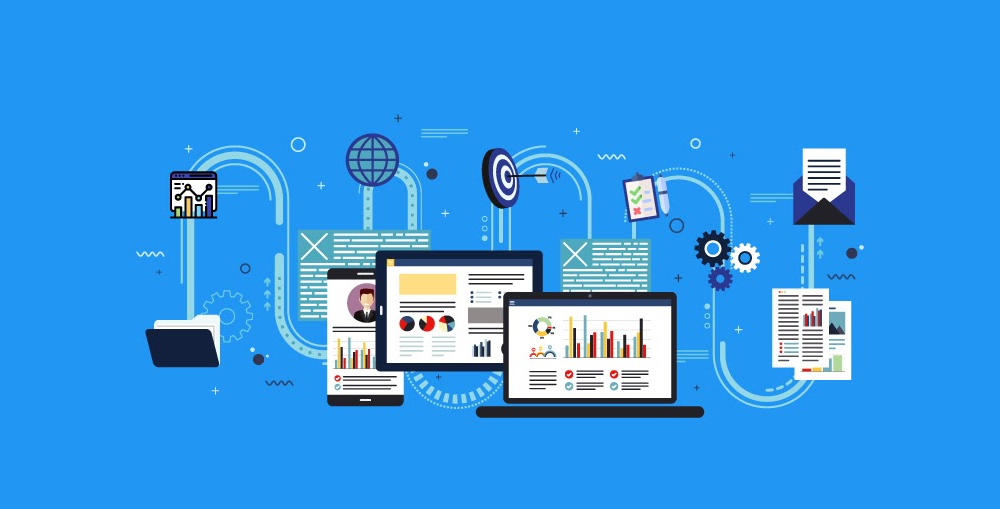A high-performing workforce is not a desirable asset but it is an absolutely essential in today’s highly dynamic and competitive market landscape. Businesses need highest possible operational efficiency and performance in order to effectively achieve their strategic goals and long-term objectives. High-performing workforce is the strongest catapult that can help businesses and organizations to achieve long-term and sustainable success. Businesses invest huge sums of money and efforts in implementing top-notch technologies, innovative solutions and information infrastructure, however, all these efforts will only work if you have a capable and productive workforce.
A performance management system is a digital solution which helps businesses enhance collaboration and communication between all business functions, which is vital for success. That is not all, in order to ensure success and progress, a business must also align its performance management processes with its strategy and business outcomes. This is what can make a huge difference. Businesses in Dubai, Sharjah, Abu Dhabi and all around the UAE do have their performance management systems, however, most often businesses and organizations doesn’t emphasize much and consider it as a “nice to do” kind of activity.
However, things are changing rapidly, with the rising competition and skyrocketed customer demands, businesses are now compelled to seriously consider their performance management practices. In this blog we will discuss how a digital performance management system can help businesses linking performance management to business outcomes and objectives which can greatly enhance efficiency, performance and profitability.

Performance Management System Helps Aligning Performance Management to Business Outcomes
By implementing a modern performance management system businesses and organizations can effectively link performance management processes and strategy with the business outcomes which will help them effectively monitor, measure, and improve both individual employee performance and the team performance, which resultantly help driving the growth and success. In today’s dynamic and fast-paced business landscape the performance management is an ongoing process. It continuously keep improving the productivity and operational efficiency which lead to a long-term sustainable success.
A performance management system helps setting up SMART goals, key performance indicators (KPIs) and a comprehensive tracking framework which effectively aligns high-level organizational goals and strategic objectives with individual goals. Here are some key advantages of implementing a modern performance management system which help businesses and organizations to link performance management with their crucial business outcomes – to enhance performance and productivity of the entire organization:
Align Performance with Strategic Objectives
The primary and most crucial part of a performance management system is to aligning the individual and team goals with the broader and high-level organizational goals. One of the biggest obstacle in this process is the communication and the performance management system offers tools and mechanisms to greatly boost the communication and increase employee engagement which help businesses effectively aligning individual employee goals with the high-level organizational goals. Another great feature of a modern performance management system is that it cascades high-level organizational goals down to individual.
Furthermore the managers can reinforce this connection by conducting regular goal-setting sessions, performance review, and regular feedback sessions. The performance management system provides a systematic approach to manage, track and record those interactions which driving transparency as well and help gaining employee’s trust. All these features help employees understand their goals and objectives and their contribution in shared goals and strategic objectives.

Set Clear Expectations and Define Success
The effectiveness of any performance management system depends on its ability to provide effective mechanisms, tools and system to establishing clear expectations and defining the success to the individual employees. Setting up clear expectations for the individual employees can greatly raise their morale, it tells them what business is expecting from them and give them a better understanding of what success will look like. Hence the employees have a very clear understanding of their goal and contribution.
All modern performance management system support SMART framework for goal setting, here the SMART means Specific, Measurable, Achievable, Relevant and time-bound. Businesses and organizations can provide employees a complete roadmap to success by clearly defining their job roles, responsibilities, expectations, goals and success. This clarity driven by the modern digital performance management system not only helps employee to understand their goals and business’s expectations from them, but it also help managers in appraisal reviews and performance feedbacks, elevating and enhancing the entire performance management system.

Streamline Regular Feedback and Coaching
Regular feedback and coaching are imperative for fostering growth and a productive organizational culture. The regular feedback is crucial for boosting performance, it helps understanding the areas of improvement and which is crucial for course-correction. Furthermore regular coaching and guidance boost employee’s morale and results in higher productivity. When the employees and managers communicate and interact regularly, the employee engagement increased, which is crucial for a high-performance workforce.
The regular feedbacks not only help identifying the areas of improvements but it also help understanding the challenges and obstacles employees are facing which could be rectified to increase productivity and efficiency. A modern performance management system provides structured mechanisms and tools to improve the feedback and coaching processes. It helps documenting and communicating the feedback and recording each and every interaction. Furthermore the performance management system also incorporate the coaching, training and development opportunities which can be greatly enhance employee performance in the long-term.

Monitoring Performance and Progress
A modern performance management system offers advanced monitoring tools including AI tools, smart algorithms, integrated data collection tools, intuitive monitoring dashboards and customized reporting tools. The performance monitoring includes a systematic framework of tracking and evaluating the individual employee, teams, departments, and entire organization’s performance and progress towards preset goals, objectives, benchmarks, KPIs (key performance indications) and industry standards. A real-time data collection and monitoring mechanisms help management keep a close eye on ongoing progress and make course correction or take action in time to maximize the efficiency and productivity.
Through regular and continuous monitoring and evaluations businesses and organizations can effectively track the progress towards the set goals and objectives. This gives management an opportunity and capability to intervene quickly to minimize and rectify the performance issues and help them achieve their performance goals and strategic objectives. Furthermore it also help businesses and organizations to uncover the underlying factors which are impacting the performance and it also help them in taking preemptive measures to keep progress on track.

Rewards and Recognitions Program
The recognition and reward for the high-achiever could be the most effective and impactful catalyst in driving the performance, employee engagements, motivation and productivity. The rewards and recognitions are not just to praise the high-performer, but it is a system to enforcing the desired behavior and outcomes. A systematic approach towards the reward and recognition program help businesses and organizations to foster a highly productive culture of accountability, transparency, and appreciation for the hard work.
A modern performance management system provides tools and mechanisms to make reward and recognition programs more justified, transparent and impactful. A good reward and recognition program help businesses to develop their workforce as per their emerging needs, and it help them compete and thrive in the market. Appreciation of the hard work motivates employees, encourage them to perform well and inspire low-performer to make improvements. An excellent reward and recognition program is essential for performance management, it also help attracting and retaining talent.

Identifying Performance Gaps and Employee Development Needs
Most of the business leaders and HR doesn’t realize that the performance management is not only about evaluation the past performances, but it is a full package that also includes defining the future trajectory of the individual employees as well as the entire organization. Most of the times employees failed to achieve their expected goals, despite putting their best efforts. However, this problem can easily turned into power, by effectively identifying the performance gaps and employee development needs. Identifying the areas of improvements and growth opportunities can help businesses and organizations to unlock the true potential of their workforce.
A digital performance management system provides a comprehensive framework to deal with such matters. With in-built monitoring and feedback tools, managers can easily identify the areas of improvements through constructive feedback, constant monitoring, regular coaching and evaluation. This will help them identifying the opportunities for training and development which will eventually help enhancing the employee performance and success. The performance improvement plans are crucial for elevating the both technical and behavioral competencies of the employees.

What is a Digital Performance Management System?
Traditional performance management systems rely on periodic reviews, assessments and feedback and often include a lot of manual work. A digital performance management system on the other hand is a robust solution comprising of tailored digital tools, software integration and real-time monitoring and analysis tools which make performance management more agile and impactful. The digital performance management system provides tools and methods that facilitate both traditional and modern performance management practices along with advanced analytics to monitor, evaluate and optimize the performance in real-time.
A modern digital performance management system provides continuous feedback, highly transparent assessments, and advanced tools to enhance communication and collaboration between the employees and the managers. It helps aligning the high-level organizational goals and objectives with individual employee goals and team goals and it also provide tool and mechanisms to helps businesses linking performance management to business outcomes.
Here are the key components of a modern digital performance management system:
- Continuous Performance Monitoring: With in-built advanced analytical tools and intuitive dashboards the managers can continuously monitor performance metrics, quality of work, goal and task attainments, and much more having higher visibility and control.
- 360 Degree Feedbacks: Businesses can incorporate 360 degree feedbacks within their performance management process. Digital performance management system provide tools to gather feedback data from various sources and consolidate them seamlessly in the insights.
- Goal Setting and Alignment: With in-built advanced tools, managers and HR leaders can implement SMART framework or customized approach to set up goals and then scale them down to establish individual employee goals to ensure higher alignment and better performance.
- Effective Development Plans: A performance management system provides a wealth of performance data with in-built analytical tools and reports which help HRs to create effective employee development plans by identifying their skill gaps, aspirations, career path and interests.
- Performance Insights and Analytics: A digital performance management system comes with customizable dashboards powered by smart analytical software engine. This empowers both managers and employees with analytical tools, reporting dashboards and insights.
A digital performance management system is a customizable tools which help businesses implement a tailored solution which aligns with their unique goals and help enhancing their organizational culture for higher productivity, performance, profitability and growth.

Conclusion
Linking performance management with the business outcome is not about conducting annual reviews, or biannual reviews and appraisals, in fact it is an era of a modern performance management approach that appreciates data driven decisions, continuous feedback and help fostering a collaborative and productive organizational culture. Implementation of a digital performance management system that supports modern performance management methodologies is not optional, but a necessity to survive and thrive in competitive markets like in Dubai, Sharjah, Abu Dhabi and in broader UAE. In this fast-paced business landscape, where the customer demands keeps changing, the market trends could shift in days, the employees have more opportunities and the competition is rising day by day, a business needs a highly effective performance management system that not only elevate their operational capabilities and performance but also help fostering a culture of performance and productivity.
Higher employee engagements help driving performance, employee satisfaction and raise employee retention. The employee retention is crucial for a long-term success. The performance management system helps aligning the individual goals with the high-level organizational goals and strategic objective boosting the outcomes. In this blog we have discussed how crucial it is to link performance management to business outcomes and how this can be achieved with a modern digital performance management system. If you want to learn more about the subject or if you want us to help you implementing a tailored performance management system for your business or organizations, please feel free to contact us through our Contact Us page or leave a comment in the comment box below and we will get in touch with you soon.